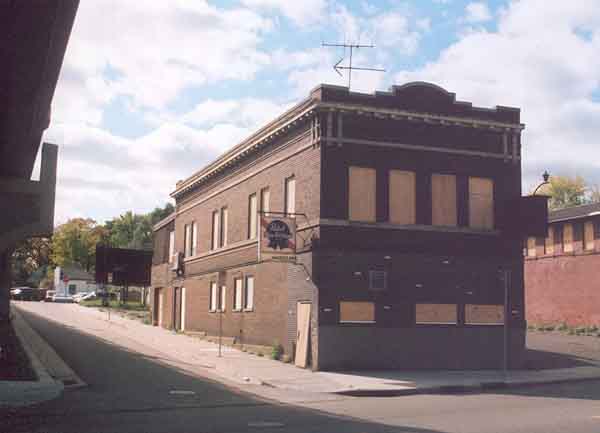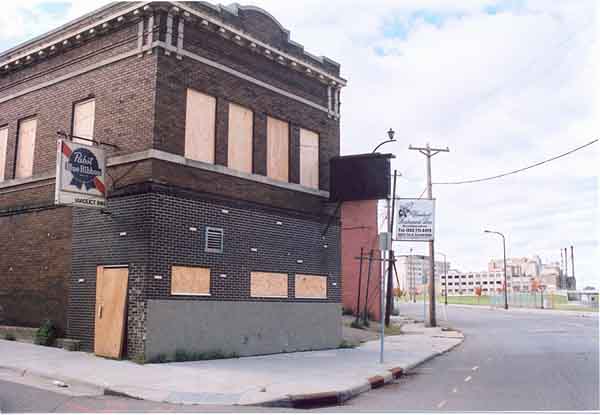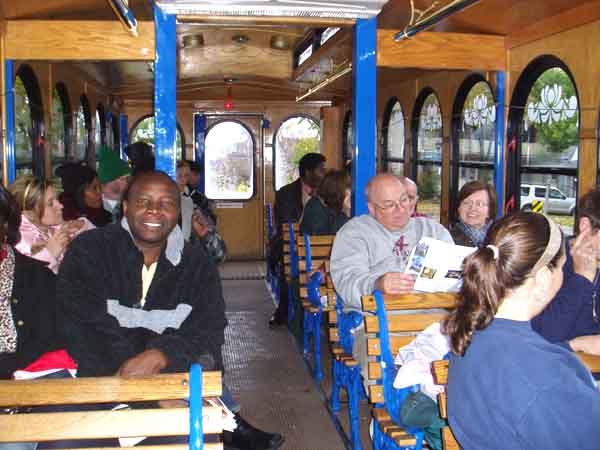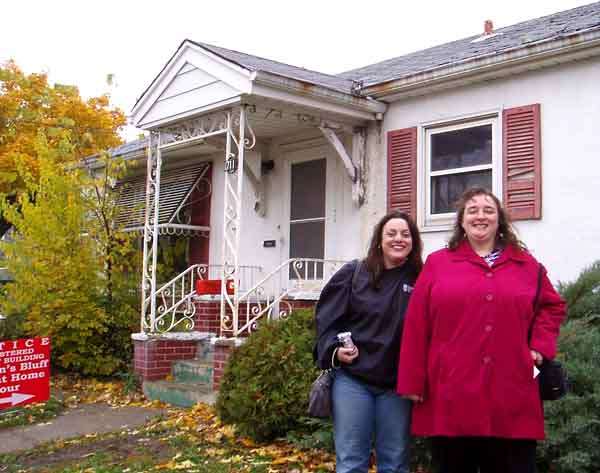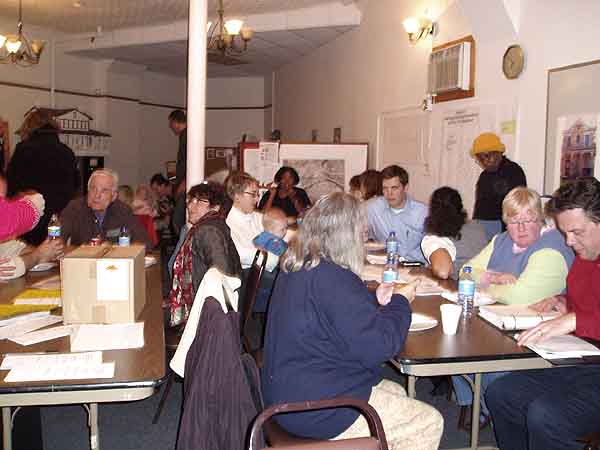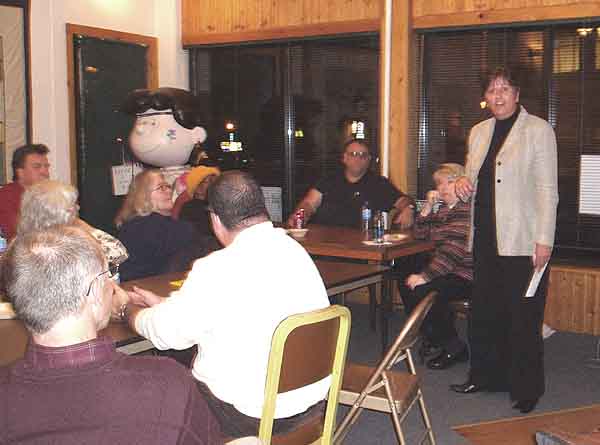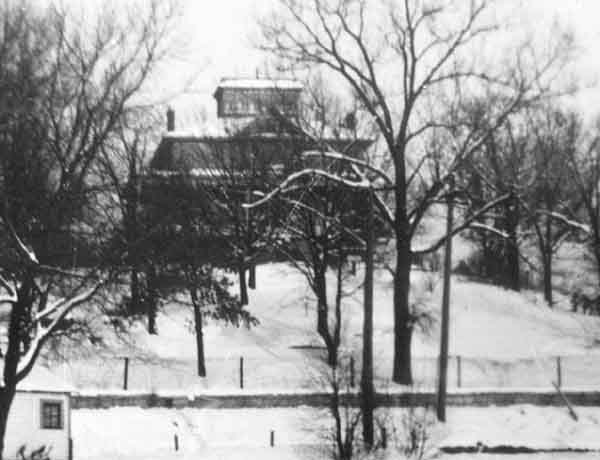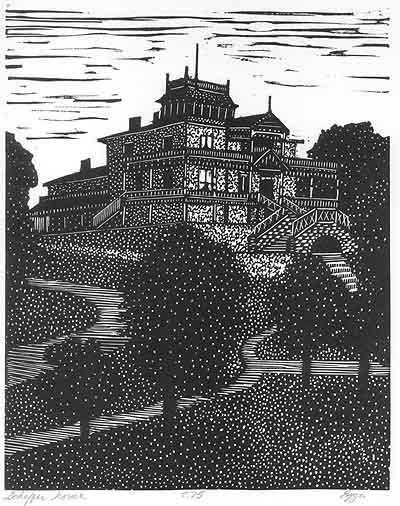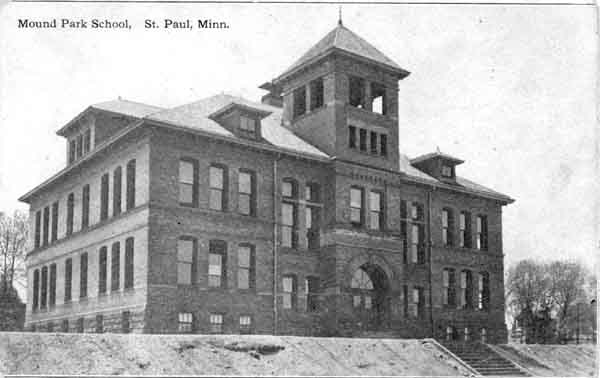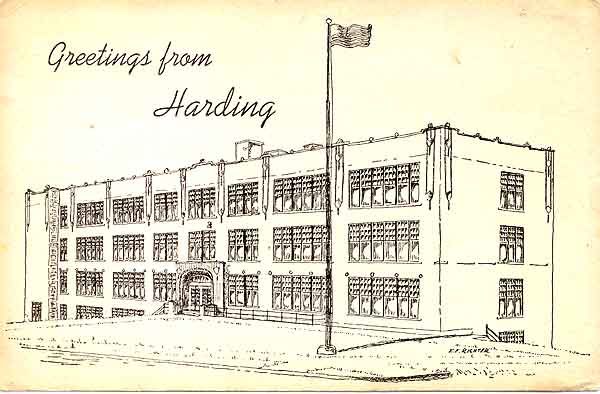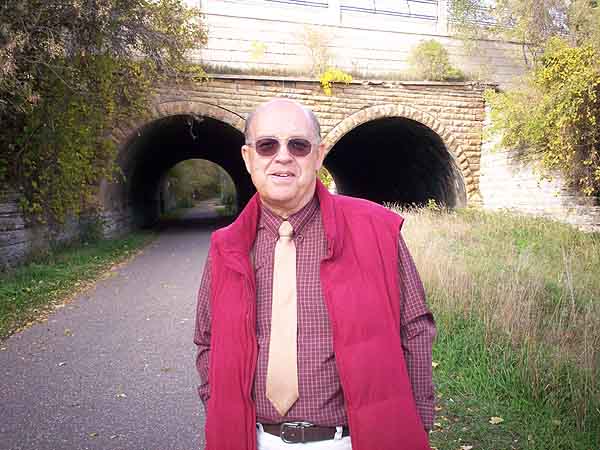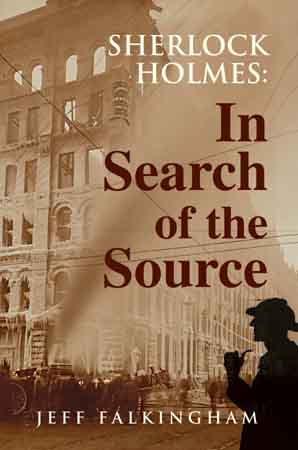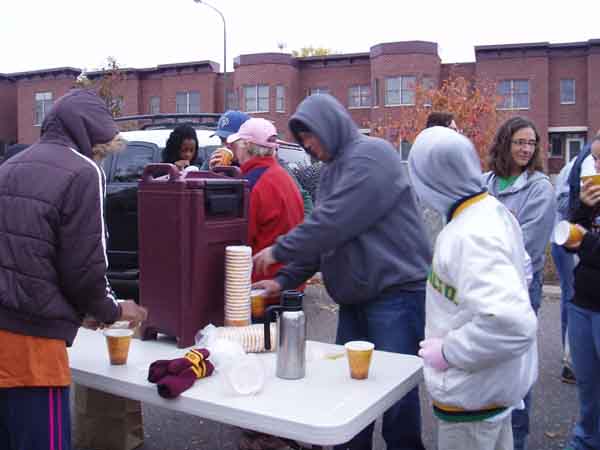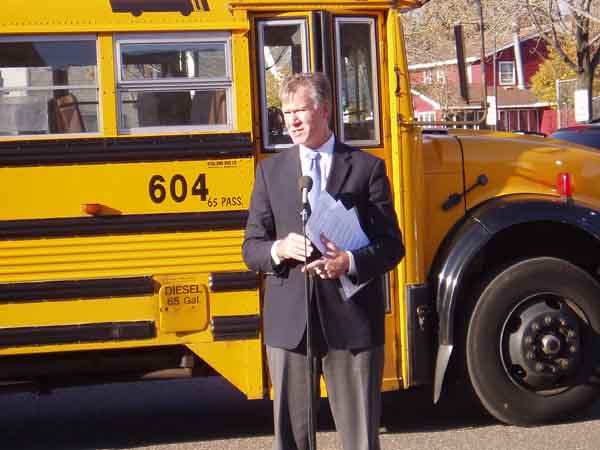| Dayton's
Bluff District
Forum December
2008
Volume 21, No. 10 IN THIS ISSUE
1. More historic buildings come tumbling down 2. R.I.P. Viaduct Inn 3. Dayton's Bluff Community Meeting 4. Block club meetings 5. Second Vacant Home Tour successful 6. Lantry says Dayton's Bluff is "energized" 7. Meet the police 8. Take a Hike 9. Put your home on the 2009 Minneapolis & Saint Paul Home Tour 10. Want to start your own business? 11. Book talks and signing - Great Christmas gifts 12. "A Christmas Story" at the Mounds Theatre 13. Neighborhood Family Movie Night 14. Last chance for Neighborhood Honor Roll Candidates 15. The final Dayton's Bluff house history tour - At least for awhile 16. Learn about new home ownership and personal financial topics 17. Happy days at Harding High School 1957-58 18. Children need presence more than they need presents 19. Sherlock Holmes in Dayton's Bluff?! You better believe it. 20. Swede Hollow invasive plant removal 21. CLUES celebrates 27 years of service to the community 22. Big turnout for Election Day 23. The Circulator Bus is still circulating 24. Set of 12 Dayton's Bluff postcards available 25. Church Directory 26. Miscellaneous Stuff 27. December Ads Past issues of the Dayton's Bluff District Forum |
|||||||||||||||||||||||||||||||||||||||||||||
|
More
historic buildings come tumbling down
By Nick Duncan Halloween 2008 was scary for all the wrong reasons on Dayton’s Bluff. This year instead of the usual Halloween ghosts, ghouls and things that go bump in the night, the scariest sight to many Dayton’s Bluff residents was the bulldozers of the St Paul Port Authority. On October 31 a demolition crew hired by the St Paul Port Authority tore down a local landmark-the Viaduct Inn on 7th and Earl Street. Many Dayton’s Bluff residents were not only saddened by the loss of the Viaduct but stunned by the suddenness of its demise. The Viaduct, along with 3 other smaller buildings on the 1000 block of East Seventh, was purchased by the St Paul Port Authority in June. By the first week of November, less than six months later, the Port Authority had razed all four buildings. Many neighborhood residents are greatly concerned that the Port Authority has become far too destructive in its approach to urban renewal. “The Dayton’s Bluff Community Council has gotten many calls wondering why so many of our historic brick buildings are being torn down by the Port Authority,” wrote community organizer Karin DuPaul in an e-mail to local residents. In an eerily similar situation a month earlier the Port Authority, without consulting local historical preservation groups or neighbors, tore down the neighboring historic Globe Building. The Port Authority’s plan is to buy up as much land as possible near the 45-acre site of the 3M plant just north of 7th Street. The city has made an agreement to buy these 45 acres from 3M with the hope of moving county government offices out of downtown and into new offices along the Phalen corridor. The Port Authority believes it can create millions in private investment and over 1200 new jobs with its renewal project. Not everyone is sold on the Port Authority’s plan. One longtime Dayton’s Bluff resident argues, ”I for one am pretty fed up with the PA. Apparently, their plans are to tear everything down along East 7th and Phalen Boulevard, and then sit on the open scrub land until some developer happens along to build something of ‘value’.” Neighbors also question the viability of expecting these lands to be developed during a recession. But what upsets other Dayton’s Bluff residents the most is the Port Authority’s penchant to raze buildings without warning. “The Port Authority continually acts without informing the neighborhood of what they are going to do,” says Dayton’s Bluff resident Steve Trimble. To tear down a privately held building in St Paul is a long process with plenty of checks and balances. It starts with the building being declared vacant, and continues through a number of steps, including allowing public input, and culminates with a vote of the entire city council. However, once a property is purchased by the Port Authority these rules and procedures don’t apply. “Once the Port Authority has it, they can do what they want,” says DuPaul. Trimble points out that, unlike other St Paul neighborhoods where the Port Authority has gone out of its way to solicit neighborhood input (for example, setting up a planning group that includes Highland Park residents on the issue of re-using the Highland Ford Plant) the Port Authority has shown little interest in input from residents of the Eastside. Trimble believes that it could be due to the income disparities between the two neighborhoods. Many neighborhood residents are baffled by what they see as the short sightedness of all these tear downs. Dayton’s Bluff resident Matt Mazenec opined for many when he wrote: “Who are we to say that something old and around for a century needs to be destroyed when we really only consider the decision for a minute in this building’s history. A permanent solution and an ugly one at that. For how many years in this city have we looked back at our history and thought ‘Why on earth did we tear down that beautiful building.’ Heck, downtown was filled with these structures which are now parking lots. All I can think of is how sad and what a waste. We could never recreate these buildings, we can never come close. We all talk about living green in our world yet we destroy perfectly fine buildings in the name of ‘progress’ and throw its contents into a landfill. I don’t think I like the new green if this is what it entails.” Whether it’s labeled progress or destruction, the bottom line is the Viaduct Inn is no longer standing and many local residents are left wondering which of our neighborhood landmarks will be next to go. The Dayton’s Bluff Community Council, Payne Phalen District 5, and District 2 hosted a meeting about the 3M site and the Port Authority on November 20 which is after deadline for the District Forum. We will update readers on the meeting and this continuing story at a later time. R.I.P. Viaduct Inn
The Viaduct Inn was built in 1913 by the Hamm’s Brewery. During that era it was common for breweries to build saloons where they could exclusively sell their own beer. Over the next 95 years, the Viaduct Inn changed hands a number of times but almost always stayed open, serving drinks and food to neighborhood residents and workers at the nearby factories and manufacturing plants, including 3M, Whirlpool and Globe Asphalt. The Viaduct also played an integral role in the lives of many of the local blue-collar workers by serving as a bank to allow them to cash their paychecks. The Viaduct Inn stood alone almost directly under the Earl Street Viaduct with the “Viaduct Inn” sign hanging out front. This facade was so distinctive that it was used not once but twice in major Hollywood movies: “Joe Somebody” (2001) and “That Was Then…This Is Now” (1985). Anybody who ever ventured inside the Viaduct will never forget the uniqueness of its interior. The tin ceiling, tile floor and the long intricately carved oak bar, complete with brass rail, mirrored back, stained glass and a slogan ornately carved into the woodwork above the bar. The Forum hasn’t been able to come up with the exact wording but it is something to the extent of “Some Drink to Celebrate, Others Celebrate the Drink.” But far and away the most unusual feature of the Viaduct was the one that lined the base of the massive oak bar. Let’s put it this way. Back in the olden days, a working man never needed to wait in line to use the rest room at the Viaduct Inn. A tin trough, complete with flowing water and a drain, ran along the bar under the brass foot rail. Dayton's Bluff Community Meeting The next Community Meeting is Thursday, December 4th from 6:30 to 8:00 p.m. in the meeting room at the Dayton’s Bluff Community Council, 798 East 7th Street at the corner of 7th and Margaret. Future meetings are January 8, 2009 and February 7, 2009. The Forum does not print in January and February so mark your calendar now. The Dayton’s Bluff Community Council holds its Community Meeting on the 1st Thursday of each month. The purpose is to work with block clubs and neighborhood residents on problem properties, criminal and nuisance behavior, code enforcement issues and any other neighborhood issues, concerns, and/or new ideas for improvement in Dayton’s Bluff. If you can get me the addresses of problems ahead of time I can get them to the police and code enforcement. Then they can bring information about the problems to the meeting. All Dayton’s Bluff residents are welcome to attend. If you need more information email Karin@DaytonsBluff.org or call Karin at 651-772-2075. Block club meetings * Wilson Avenue Block Club meets on the second Wednesday of each month at Mounds Park United Methodist Church, at Earl and Euclid, at 6:30 p.m. * Lower Dayton’s Bluff Block Club Kickball meets on the second to the last Tuesday of each month at Dayton’s Bluff Rec Center at 800 Conway at 6:30 p.m. Kids and parents are welcome. Kids play, parents talk. * Margaret Rec Center Block Club meets on the second Thursday of each month at the Margaret Rec Center, at Margaret and Frank, at 6:30 p.m. If you wish to have your block club listed, or need information about starting you own block club, please contact Karin at 651-772-2075 or Karin@DaytonsBluff.org. Second Vacant Home Tour successful
By Karin DuPaul The second Vacant Hour Tour was a wonderful success. The fall tour had about 150 people attending. Eight homes were on the tour and open for viewing. Presently three of the homes have purchase agreements pending and at least one other house has people working on getting estimates of costs of the work that needs to be done. Several houses around 100 years old had ample wood trim, floors, and built-ins to show off. One little house from the mid-20th century was vintage indeed with its rose carpeting, built-in dressers, and curved kitchen banquette. The homes on the tour highlighted the fact that Dayton’s Bluff, though known for its Victorians, in fact holds a wide variety of houses. There is great potential for finding one’s dream home here. For two months before the Dayton’s Bluff Fall Vacant Home Tour, the Vacant Building Committee spent their Sunday afternoons looking at vacant homes throughout Dayton’s Bluff that would be good candidates for the fall home tour. The goal was to have six to eight homes on the fall tour. They needed to find about 18 good candidates, because vacant homes sell very quickly. By the time the vacant home tour brochure was to be printed we had to change two of the homes at the last moment because the homes were sold. And this is a good thing. Looking at vacant homes is always an adventure. Committee members go upstairs, downstairs, and into the basement. Some homes have beautiful woodwork, some last redecorated in the 1970s, others have stained glass windows, and others are right out of the 1950’s. Many retained their original features. The Committee likes to have a cross section of different features on the Tour. Something for everyone. One afternoon they walked on the porch of a Victorian house to the strong odor of gas. They quickly called 911 and the fire department came and shut off the gas and vented the house. Eyewitness News came out to talk with the Committee about how they responded to this emergency and diverted a disaster, and about the upcoming vacant home tour. Unfortunately the story did not make it on TV. The Vacant Building Committee will continue to work on vacant housing issues through the winter and plan the next vacant home tour in May. For more information email Karin@DaytonsBluff.org. or call Karin at 651-772-2075. Lantry
says Dayton's Bluff is "energized"
By Karin DuPaul The Dayton’s Bluff Community Council hosted their Annual Meeting and Pot Luck on October 20th. The outstanding food included chili, egg rolls, sushi, and pie, just to name a few. Two new board members were elected during the board election: Lara Merrill in Subdistrict B and Susan Richter in an At Large seat. There are two open seats in Subdistrict A, which is the northeast area of Dayton’s Bluff. If you are interested or need more information, email Karin@DaytonsBluff.org or call Karin at 651-772-2075. City Council President Kathy Lantry addressed the group with the yearly “state of Dayton’s Bluff” address. “Energized” is the state of Dayton’s Bluff. She cited a number of examples of Dayton’s Bluff energy: The Sixth Street Block Club put in a CIB (Capital Improvement Budget) proposal for street improvements to enhance the streetscape and traffic calming on East 6th Street from Maria to Hope. And they got it. Work will start in the spring. Margaret Rec Block Club is working with Recreation Center staff on plans to improve the center by either rehabbing the current building or constructing a new rec enter building that is a more energy efficient. The Lower Phalen Creek Project Steering Committee, the group that has been instrumental in developing the Bruce Vento Nature Sanctuary, is now at work developing the old 293 Commercial Street building and site into an interpretative center for the Nature Sanctuary and a connection from the Bruce Vento Regional Trail to the Samuel Morgan trail along the Mississippi River. Mounds Park residents are working on turning the Mounds Park Maintenance facility back into a recreation center for the community. Dayton’s Bluff residents worked to have Dayton’s Bluff projects be part of the HGTV “Change the World Start at Home” Program. The Dayton’s Bluff Vacant Building Committee held two successful Vacant Home Tours as a way to get new homeowners into available homes in Dayton’s Bluff. The Bluff has many people who see a need and get busy doing something about it. Meet the police The
Eastern District Police host their monthly meetings for community
members at 722 Payne on the corner of Payne and Minnehaha Avenues. One
is on the third Wednesday of each month at 6:30 p.m. and the other on
the third Friday of each month at 9:30 a.m. In December the meetings are on the 17th
and 19th. Dayton’s Bluff Take a Hike occurs on the
first Saturday of most months. The next hike is Saturday, December 4th.We meet at
10:30 a.m. in Indian Mounds Park at Earl St. and Mounds Blvd. We’ll
hike from Mounds Park to the Bruce Vento Nature Sanctuary and then walk
along the Bruce Vento Recreational Trail through Swede Hollow Park to
the new East Side Heritage Park. Along the way we will share stories
and learn some local history of the area. The hike is about four miles
long with some moderately rough terrain. Transportation will be
available to return to Mounds Park, or you may hike back. Put
your home on the 2009 Minneapolis & Saint Paul Home Tour “I would recommend to others that they open their homes. It’s an amazing ego boost,” said one of last year’s participating homeowners. Others said they liked the push to get their home improvement projects done in time for the tour. “During fall and winter gatherings, homeowners can ask their families and friends to save a few hours on that last weekend in April,” said Margo Ashmore, Tour coordinator. Minneapolis Neighborhood Revitalization Program (NRP) manages the tour as a celebration of city living that encourages homeowners to improve existing housing stock. Many organizations and businesses sponsor the tour. Contractors and other vendors may nominate homes they have worked on, and are encouraged to call for more information. Green, energy efficient, and historically sensitive remodels and expansions get special notice. For more information, call Tour Coordinator Margo Ashmore at 612-673-5103 or email her at link@nrp.org. The application can be downloaded from www.MSPHomeTour.com. Email Karin@DaytonsBluff.org or call Karin at 651-772-2075 and let us know if you want to be on the 2009 Home Tour. The Community Council is looking for six to eight homes to be on the Dayton’s Bluff Neighborhood Tour at the same time as the Minneapolis & Saint Paul Home Tour. Dayton's Bluff spring business class The next Dayton’s Bluff Neighborhood Microentrepreneur Class is starting in April 2009. This program helps start-up and young businesses on the East Side. All East Side entrepreneurs are welcome. Class training lasts 8 weeks and includes topics such as operations management, marketing, financial management, one to one assistance with creating a successful business, and preparing a business plan, plus 8 hours of one on one time with the instructor. Those who successfully complete the course and locate their businesses in target neighborhoods are eligible for ongoing business support services. Some examples of businesses started by people who have previously taken this course include graphics, landscaping, photography, food service, restoration of wood furniture and works of art, custom floral design for weddings and events, and exterior and interior painting. The course is sponsored by the Dayton’s Bluff Community Council and the Neighborhood Development Center. There is a small registration fee based on a sliding fee scale. The next session will start in April 2009 and class size is limited. Please call Karin at 651-772-2075 or email Karin@DaytonsBluff.org for an application. Book
talks and signing - Great Christmas gifts Welby R. Smith author of Trees and Shrubs of Minnesota will
be at the Dayton’s Bluff Community Council, 798 East 7th Street on
Tuesday, December 2nd starting at 6:30 p.m. for a discussion about his
book. With more than two hundred tree, shrub, and woody vine species in
Minnesota, anyone with an interest in the outdoors has likely
encountered an unfamiliar plant and wondered about its name, origin,
characteristics, and habitat. This book is a great addition to a family
library. "A Christmas Story" at the Mounds Theatre The Historic Mounds Theatre and the Portage for Youth are proud to present live on stage their 5th annual production of “A Christmas Story” by Jean Shepherd.This classic movie is brought to life on stage for the fifth year in a row to celebrate the 25th anniversary of the film’s release Humorist Jean Shepherd’s memoir of growing up in the Midwest in the 1940s follows 9-year-old Ralphie Parker in his quest to get a genuine Red Ryder BB gun under the tree for Christmas. Ralphie pleads his case before his mother, his teacher and even Santa Claus himself, with the same and always consistent response: “You’ll shoot your eye out kid.” All the elements from the beloved motion picture are here including Ralphie’s father winning a lamp shaped like a woman’s leg in a net stocking as a major award; Scut Farkas, the school bully; the boys’ experiment with a wet tongue on a cold flagpole and more. All profits from this play go to the Portage for Youth to support its programs. Dates: December 5, 6, 12, 13, 19, & 20 at 7:30 p.m. December 7, 14, & 21 2:00 p.m. Tickets: Adults: $15.00 Students/Seniors (55+): $10.00 Children (12 and under): $5.00 Order your tickets now because the sell out quickly. Tickets may be purchased by calling the Mounds Theatre at 651-772-2253 or by visiting our website at www.moundstheatre.org. The Historic Mounds Theatre is located at 1029 Hudson Road, St. Paul, MN 55106. Neighborhood Family Movie Night It’s Neighborhood Family Movie Night on Sunday, December 14 at Mounds Park United Methodist Church (Earl and Euclid Streets, just 2 blocks south of 3rd St.). Table and card games begin at 4 p.m. Dinner is served at 5:30 (free-will donation). The movie (“It’s A Wonderful Life”) will be shown at 6 p.m., projected onto a large screen. Popcorn and lemonade will be offered during the movie. Candy will be for sale during the movie by the Youth Group to help support their Compassion Child from India. Last
chance for Neighborhood Honor Roll Candidates The Saint Paul Neighborhood Honor Roll started in the 1980s and is a listing of Saint Paul citizens who have done outstanding service in their neighborhoods over a long period of time. Each year all 17 District Councils can add three names to the honor roll. Past honor roll inductees volunteered for years at a church or a school, served on their community council board of directors, were block club leaders, led projects like buckthorn removal or spearheaded a community event. Last year the Dayton’s Bluff District 4 Community Council added Jacob Dorer, Jean Comstock, and Juanita Westman, for their years of service in the Dayton’s Bluff neighborhood. The Saint Paul Neighborhood Honor Roll is located in the hallway on the third floor of Saint Paul City Hall. The quality and amount of volunteer time that make our communities better is amazing in Saint Paul. The final Dayton's Bluff history tour - At least for awhile By Steve Trimble Here’s the third and final heritage tour of Dayton’s Bluff in this newspaper—at least for a time. The first was within the official historic district and the second outside it but still on the north side of I-94. This one will be some of the landmark houses south of the freeway in the Mounds Park area. This part of the community had some very early development with mansions that overlooked the river, but then not a lot of other construction until the Twentieth Century. This can be explained by the fact that it was not served by a streetcar and did not fill in until the start of the automobile era. It may seem a little unexpected, but this tour—really more of a list—will feature some of the oldest and one of the newest houses in our district. And, just for fun, they will be presented in chronological order.
908 Mound Street: The Smith-Davidson-Scheffer House This is probably the oldest remaining house in Dayton’s Bluff. It is believed to have been built in 1856 although one source suggests it went up earlier. It was first lived in by Truman Smith, a man who was a banker, a realtor and a marble dealer, and at one time was among the richer men in the city. He had a love of gardening and this house with a commanding view of the Mississippi River was adorned with a variety of flowers and, among other things, an acre of grapes. Along with many others, Smith was wiped out in the 1857 financial panic. His career as a banker was over and after a protracted legal battle, he lost his house. To survive, Smith turned a green thumb into a livelihood and there was soon a major garden on Dayton’s Bluff whose products were sold at the Farmers’ Market and elsewhere. In 1866, Smith had 5,000 well trained vines of forty different types of grapes, raised ten varieties of pears, and 30 different kinds of apples. He was selling hardy roses, fruit plants and evergreens and put out a catalog that listed a wide selection of small fruits and other plants for sale The house was subsequently owned by steamboat magnate William Davidson, who had a glassed-in pilothouse built on top so he could observe the river traffic. After the house had fallen into disrepair, it was won in a raffle by a Dr. Murphy, and was later occupied by banker Albert Scheffer who lived there from 1886 to 1899 and did a major remodeling that added many Victorian features to the structure. Like Smith, he lost title because of an economic depression. For a time it became a military academy, and then in the 1940’s Mrs. Mildred Evans restored the structure for a nursing home. It is still there, now known as the Mounds Park Residence. 155 Urban Place: The Curtis-Watson House The story of this Greek Revival style was covered in an earlier issue of the Forum, but it fits into this article and you may well have forgotten it. This two-story, 1531 square foot, seven-room house was on what was then called Lizzie Street. It was built for banker Orin Curtis in 1858 according to one reminiscence. The Curtis family left the house in 1867 and Robert Watson then moved in and lived there until his death in 1899. After that, his son John was there and according to one source he farmed nearby. 1150 Pacific: The William King House This house, whose old appearance has been greatly altered, is one of the few remaining physical links to the neighborhood’s more rural roots. Its first owner, William King, came to the U.S. from England and settled in Dayton’s Bluff in 1872. He purchased five acres of land and built this home in the same year. The house was small, with a kitchen, a parlor and three bedrooms. The bathroom-outhouse actually was behind. King loved horticulture and the land was then outside the city limits, so he established a wholesale florist business with several greenhouses on the back lot. Even after Pacific Street was graded to his house, it took many years for city water to arrive. All of the hundreds of plants had to be watered by hand from a pump. He married Bertha Miller on August 30, 1877. That same year he opened a retail shop on Seventh Street in St. Paul’s Lowertown. King had platted most the land into lots in 1866, but they did not sell well and he still owned most of them when he retired in 1912 at age 68. He died ten years later on January 10, 1922. King, according to his granddaughter, “was not a big man, very distinguished, soft-spoken, always immaculate, with beard and moustache; the typical English gentleman.... Dinner was always an experience at Grandpa’s house. The table was always set in ‘English style’ with the plates all stacked up at one end. The plates would then be passed to grandpa, who sat at the head of the table, carving the meat and placing the food on each dish.” 868 Mound Street: The Cyrus Brooks House While building permits were not kept before 1883, it is believed, but not certain, that this structure dates to 1874. The building has two stories and ten rooms. The Reverend Cyrus Brooks resided at this address from 1875 to 1902, the year he died of old age. He had been born in Vermont in 1811 and in 1833 became a minister of the Methodist Episcopal Church. He served in a variety of locations before coming to St. Paul in 1857. A local publication entitled Pen Pictures said that Brooks was “a tall, spiritual looking man, with a gentle stoop of the shoulders, gray hair, clear pleasant eyes, and always bearing an amiable expression on his countenance... a real good man.”
998 Pacific: The Old Mounds Park School Old Mound Park School was constructed in 1891 and is the oldest public school building still on its original site. While it came to be referred to as Mounds, originally there was no “s” in the name. If you don’t believe that, take a look at the name carved over the front entrance. It was designed by the well-known architectural firm of Buechner and Jacobson. As the area’s population increased, there was a 1910 addition. A few old timers still remember a big fire in the school in the 1930’s. It ceased to be used for education in the 1970’s when the school was merged with Van Buren into Dayton’s Bluff Elementary. It served for a time as a city owned building that housed the Community Council and other local functions, but was eventually sold and turned into housing, which remains its function today. 827 Mound: The Giesen-Hauser House Peter Giesen, a German immigrant, took out the 1891 building permit on one of the most well known Queen Anne homes in Dayton’s Bluff. It’s the one that drivers can spy from the freeway. He started out binding books for the Pioneer Press and soon had a profitable contract with West Publishing. He was a music lover and an active member of the local Mozart Society. His wife Marie, also born in Germany, came to the city in the 1850’s. She started a costume shop in 1872 that ended up being run by family members into the early 1970’s. The couple later left the house in 1907 to move to what was considered the more fashionable Summit Avenue. The next inhabitant of the red brick and sandstone structure was Eric Hauser, whose main source of income was in contracting, mostly for railroad concerns. After his death in 1929, the house went through a number of uses. As was common at the time, a mansion like this one ended up as a boarding house. From the 1940’s through the 1970’s it was a boarding house. Unlike most of the other huge homes, it has been returned to a singe family use. 197 Maria: The Kempien House Theodore Kempien built this 1905 Tudor Revival style home on a nicely landscaped corner lot. He was a prominent St. Paul businessman who started out at age seventeen selling coffee and tea door to door. He eventually took over an already established firm, added a new partner and became quite successful. Kempien & Womack, located at 180 East Third Street, brokered merchandise and specialized in coffee and tea. He was very civic-minded, a member of the Knights of Columbus, on the board of the Mounds Park Sanitarium and served on the St. Paul City Council. 170 Maria: The Koehler House This Georgian Revival house is very little changed since its construction in 1912, at least on the exterior. Albert Koehler was a foreman at the Hamm’ Brewery who married Wilhemina, one the daughters of Theodore Hamm, the brewer. After retiring, he and his wife built their dream home that nearly filled the entire block. Wilhemina loved gardening and wanted the space. Thomas Holyoke, the architect, was working in the Cass Gilbert office at the time. Unfortunately, Albert died in 1915, but Marie Koehler lived there until 1950 and their daughter Lula until 1953. It was then sold to the order of the Carmelite Nuns of St Paul. In 1956 it became the Maria Avenue Boarding House. In the 1960’s it was bought by Alcoholic Anonymous as a residence and offices, and the Alano group still operates the facility. 852 Mound Street: The Stolpestad House Although Martin R. Brown was the first owner of this 1912 house on the edge of the bluff, the Stolpestad family was its longest-term resident. Harold L. Stolpestad, a physician who officed at 786 East Seventh Street, and his wife, Leontine Stolpestad, resided at this address from 1919 until the mid-1950’s. Two of his sons also became physicians and both were connected to the old St. John’s Hospital. In fact a second addition to the institution, constructed in 1959 along East Seventh, was named The Stolpestad Wing. Now remodeled and part of the Metropolitan State University campus, it has been renamed St. John’s Hall. 290 Earl: Supreme Court Decision Site This is a site that is noted not because of its architecture or prominent residents, but because of an unfortunate incident that led to a decision by the United States Supreme Court. It all began when an African-American couple and their children moved into their two-story frame house in St. Paul in March 1990. The neighbors were friendly—with a notable exception. A couple of local youth with racist attitudes wanted to drive them out of their home. And in the early hours of June 21, 1990, the Joneses wakened to the sound of running footsteps, looked out their window, and saw a two foot tall cross burning in their yard. Eventually arrests were made and people were convicted under a city ordinance that outlawed cross burning and any other action “which one knows or has reasonable grounds to know” will cause “anger, alarm or resentment in others on the basis of race, color, creed, religion or gender.” The attorneys for the young men appealed the decision, arguing that the ordinance conflicted with the free speech protections in the First Amendment. In a unanimous ruling in R. A. V. v. City of St. Paul in 1992, the U. S. Supreme Court said that the local law was unconstitutional, because it was too vague and violated the First Amendment to the Constitution. As a result the lower court ruling was overturned. Incidentally, after the initial incident, the neighbors had meetings to denounce racism, met with the affected family and expressed the hopes that they would remain part of the community. The Joneses decided to stay and remained in the house for many years. 865 Mound Street: The Ter Wisscha-Lano House When Glennis Ter Wisscha and Jim Lano bought an empty lot on a hilltop overlooking Mound Street for a home, they knew that they wanted to build something special. In 1995 they turned to the plans left by architect John Howe who had served as the head draftsman for Frank Lloyd Wright for three decades before coming to St. Paul in 1967. Local architectural critic Larry Millett included this house in his new AIA Guide. “Not surprisingly,” he wrote, “Howe’s designs have a distinct Wrightian quality. This house, clad in redwood siding, is of modest size and features with an octagonal living room bathed in natural light.” Another interesting part of its history has to do with one of its residents. As a young woman, Glennis was one of the “Willmar 8,” who were participants in a 1977-1980 strike against the Citizens National Bank of Willmar. Among their grievances was the fact that they had to train men who then moved into higher paying jobs not open to women. They walked off the job on December 16, 1977 because they wanted to see job openings posted, qualifications listed, and hiring based on skills not gender. After a long and often difficult struggle the National Labor Relations Board ruled in their favor and they were vindicated. Their cause was widely supported by labor and women’s groups and has been documented in more than one television production. Mounds Boulevard and Earl: The Mounds Park Pavilion Okay—so this site and the one that follows are not houses; however, they are prominent landmarks that definitely add to the area’s heritage. They have been placed at the end of the article rather than in the chronological arrangement. This prairie style structure with a horizontal feel and low-hipped roof was designed by prominent local architect Charles Hauser and built in 1916. It was patterned after similar ones that had recently been added to Chicago’s Park system. It is rarity in the Twin Cities since most other prairie styles are houses or commercial buildings. Mounds Boulevard West of Earl: The Airplane Beacon This aerial beacon, put up in 1929, is a steel tower that rises 110 feet above Mounds Park. There is a rotating light on top that was once used for visual navigation by pilots flying along an airway corridor. Approximately 1,500 such structures beacons once existed. This particular one showed the way from Chicago to St. Paul. They were spaced ten miles apart and in clear weather the beam from the 1,000-watt lamp could be seen for 40 miles. The beacons rotated at 6 rpm, creating a flash every 10 seconds. Radio navigation began to replace this visual system in 1929, so this was one of the last ever built and is thought to be the last one still standing. The Mounds Park beacon has even appeared in local literature. A young man has just brought a new girl friend to do a little spooning, as they used to say. Here’s how St. Paul writer Norman Katkov portrayed it in his 1948 novel Eagle At My Eyes: “What would you figure? Wouldn’t you think you were in? A dark night for her, brooding and thinking and telling it to the first man she saw. Wanting to sit by the beacon. What the hell, she knew you didn’t go to Mounds Park for charades.... I turned off the parkway and eased up to the retaining wall which looked south to Pig’s Eye... There wasn’t another car in the parking space and I let the bumpers touch the wall before I pulled the emergency brake. I found some music on the radio, held the lever and pushed the seat back, than sat watching her, she with her head on the cushion, the kerchief off her hair now, her face in profile as she looked down at the airport and the string of lights bordering the field.” You’ll have to read the book to find out the rest. There you are, a little more of our community’s heritage as seen in the “built landscape” that surrounds us. If the weather holds in early December, you may be able to drive around and take a look at these local landmarks. There will not be an issue of the Forum in January and February, so there’s plenty of time to do research for the next history article. Any readers have a suggestion for the next topic? If you do, drop the paper an email and we’ll see what can be done. Or maybe you’d like to send in your own history piece. All submissions are welcome.
Learn about new home ownership and
personal finances Happy days at Harding High School
1957-58
By Barbara Sommerville
By Mary Ann Cogelow On Election Day after waiting in line most of two hours to vote, my daughter and I took ourselves to a celebratory lunch at a small, real food restaurant in our neighborhood. As we waited at a sidewalk table for our meal, we observed a little episode of parenting that had a lot of skill in it. A young mom came up the sidewalk pushing her approximately two-year-old son in a stroller. He was clutching a plain, old, garden-variety stick, about two feet long, in his hands. As they approached the café, the mother said matter-of-factly, “You can’t bring your stick inside. You have to leave it here.” Pointing to a grassy spot on the boulevard, she said, “Put it there.” The little boy put the stick down, his mom said, “Thank you,” and they wheeled into the restaurant. About ten minutes later they reappeared, the mom with a takeout beverage and the child with a cookie. As she began to push the stroller away, her son uttered a nonverbal cry of protest and pointed to the boulevard. His mother stopped, said, “Oh, I forgot your stick,” pushed the stroller back, retrieved the stick and handed it to him. They went on their way. More about this later. In the November issue of the Dayton’s Bluff District Forum, I wrote about the dangers of overindulging children. In this month’s issue, I want to continue on the theme of overindulgence by thinking a little about the differences between what children “need” and what they “want”. In his thinking about human needs, Abraham Maslow developed what seems to me a comprehensive and thought provoking list. He began with basic physical needs such as air to breathe, drinkable water, food and sleep. He then described other categories of need: safety, love and belonging, esteem, and self-actualization. Within these large categories, he listed such needs as home, health, friendship, confidence, morality, creativity, problem solving, lack of prejudice, and more. Critics have argued that describing these needs as a hierarchy is inaccurate and that these needs coexist (with some developmental differences) across the life span. I agree. Nonetheless, I think Maslow provides a useful list to keep in mind when thinking about what children “need” as opposed to what they may “want.” Now a cautionary note: You can’t “spoil” a baby. In the first six months or so of their infant’s life, “needs” and “wants” are the same thing. Parents need to hear the baby’s messages, do their best to understand what the baby wants/needs, and then fulfill those needs as quickly and consistently as possible. The newborn needs to feel himself the center of the universe as a necessary first step in healthy development of every kind. Remember that while many of an infant’s needs are physical - to be fed, to be clothed warmly or coolly enough, to get enough sleep, to be helped to relieve discomfort - other needs are social and psychological. Babies need time and loving attention which stimulates all of their senses from people who love them. Indeed, these interactional needs, while they seem less concrete than food, clothing, and shelter are so essential that their lack poses a grave threat for a baby’s physical health if they are unmet. In European orphanages during the first half of the twentieth century and continuing to the present, babies who were adequately fed, clothed, and sheltered, but who did not have their needs for connection to a special, loving care giver met, often died. If a baby’s behavior (crying, smiling, reaching out, whatever) says, “I have a need,” the parent needs to do his or her best to meet that need. As children grow older it is possible to overindulge them. Once children approach their first birthdays, parents do well to remember that the child’s “I want it” message no longer always means “I need it.” For this reason, it seems useful to keep in mind children’s real needs - social, emotional, and developmental as well as material. Jean Illsley Clarke always takes my breath away when she says that we parents provide for all of our children’s needs and for some of their wants. My personal history is too close to poverty not to know that providing what children need in terms of nutrition, clothing, and shelter is extremely difficult if not impossible for many families in the United States. (This was true before the United States economy recently went south and the situation will likely worsen before it improves.) Nonetheless, it may be helpful to consider what other resources - social, emotional, psychological, and knowledge - parents can draw upon to meet their children’s needs. All of parents’ resources, financial and otherwise, are threatened by hard economic times and I want to fully acknowledge that fact. But I hope knowing in addition to the things money can buy, that children require other essentials can help parents to supply the needs that depend more on their wills than on their pocketbooks. This can lead to a better job of prioritizing the way they use what financial resources they do have whether severely limited or abundant. Sometimes parents let themselves get confused by children’s demands, or by society’s messages, and give kids things while depriving them of what they need more - for example, by overspending on Christmas gifts and running out of money for groceries before the end of the month. So to recap: all children have real needs. Some of them are material. Others are for time, attention, shared knowledge and the like. Both kinds of needs are real and essential. Both may spill over into wants which need to be limited in ways that help children grow and develop to their full potential. This brings us back to David Walsh’s assertion that even when we say “no” to a child’s desire or behavior, we make sure the child knows we heard the message and the feelings that accompanied it. This is where many parents have difficulty with their limit setting. It seems as if parents feel bound to comply with an “I want. . .” message if they acknowledge it or to give in to a child if they hear and empathize with a feeling. Parenting demands that we have the ability to really hear what our children are telling us and to be open to accepting their feelings, to be able to say to a child, “I know you want . . . ,” “I think your feel . . . ,” while maintaining our ability to consider whether or not to gratify the child’s wishes. Children do need us to really know them, to hear what they want, to do our best to identify and name and care about their feelings and then to pull ourselves up by our boot straps and make the best decisions we can about meeting their needs and granting some of their wants so their lives are enhanced but not overindulged. The mom I told you about at the top of this article was doing a nice job of hearing what her son wanted (and perhaps needed) while helping him to know that there were limits to his enjoyment of his stick (not in the restaurant), and of listening to his reminder to retrieve it. She did not put him down for wanting a “dirty old stick” as she might have, and she accepted his protest when she forgot it, easily acknowledging to him her human imperfection. The ease with which her son complied with her directions and the confidence he expressed in his relationship with her led me to imagine that this interaction represented many past incidents which had built a solid relationship of trust between mother and son. This parenting business is often a tough job. For a chance to explore overindulgence and many other parenting issues, take advantage of the multitude of resources - books, blogs, the internet, meetings on special topics - available to parents. I especially recommend joining an Early Childhood Family Education Class for information and support. Call 651-293-5343 for help locating a discussion group that fits your family and your schedule. Get some of your needs met! Sherlock Holmes in Dayton's Bluff?! You better believe it. by Erik Falkingham Jeff Falkingham has always been a big history buff. He loves reading historical fiction and watching historical films. On road trips, Jeff always has to stop and visit every single “historical landmark” he sees. Believe me, I know this because I’m his son.
Jeff recently finished his new novel, Sherlock Holmes: In Search of the Source, and get this: story is set in December 1896, and though much of the action takes place in the Lowertown District of old St. Paul, the climactic chase scene occurs in Dayton's Bluff! It begins near the Hamm's Brewery, winds its way through Swede Hollow, under and then over the Seventh Street Improvement Arches, down Maria Avenue to the caves in the limestone bluffs beneath Jacob Schmidt's old North Star Brewery, finally culminating in a moonlit fistfight atop the gently rolling hills of Indian Mounds Park. But let’s back up a minute. The story doesn’t start here. Source is actually a sequel to Jeff’s first novel, Sherlock Holmes and the County Courthouse Caper, set in his hometown of Browns Valley, Minnesota. I remember back in April 2000, when my dad told me he wanted to write a historical fiction novel for young adults. I told him, cool, go for it! But when he told me it was going to be a Sherlock Holmes novel set in Minnesota, I thought he was nuts. Or as Holmes would say, “plum loco.” Well, Caper, released in September 2001 by Beaver’s Pond Press, ended up being a big hit among the young adult audience, as well as with history buffs and mystery fans. I have to admit… even I liked it. Beaver’s Pond Press printed 1,000 copies of Caper, and they sold out by December 2002. For the next five years, the publishers kept urging Jeff to do a reprint, but, as he put it, “I didn’t think the time was right.” In March 2007, Browns Valley was hit by a terrible flood. Nearly 50 homes were flooded and over 100 people evacuated. The time had come. Jeff gave Caper a new makeover, adding both photos of real historical characters and photos from the flood, and decided to sell copies of this “Flood Edition” himself to raise money for flood relief. Jeff worked hard to raise the money for his hometown. He used every resource he could, personally selling copies to friends, relatives, neighbors, libraries and online shoppers from his website (www.cccaper.com). So far, he has raised over $6000, and donated every cent to the Long-Term Flood Recovery Fund in Browns Valley. But up to this point, he still hadn’t considered writing a sequel… Then, in November 2007, Caper got a very favorable review in the District Messenger, the official newsletter of the Sherlock Holmes Society of London. “I got a lot of interest, feedback and encouragement from Holmes fans all across the nation -- and around the world!” said Jeff. In fact, many fans liked the story so much, they suggested writing another. That planted the seed, and in January 2008, he started writing part two. “Writing historical fiction is kind of like a big jigsaw puzzle where you’ve only got about half the pieces,” said Jeff. “The historical pieces are like the corners and the edge, then you have to come up with a whole bunch of little pieces for the middle. It’s fun but it’s challenging. Fun because you get to make up several of your own pieces, but challenging because you have to make them fit with the others.” It took Jeff six months to research and write Source, which I find pretty impressive, considering he was also working two jobs at the time. He’s been a proofreader and an editor for over 20 years, and before that he was a sports writer. He said having such a large writing background was a great advantage in both the writing and revision process. When asked how much of Source is fact vs. fiction, Jeff said it’s about 40 percent fact and 60 percent fiction, whereas Caper was about 50/50. “I started with more jigsaw pieces with Caper and didn’t have to make up so much. Source was more challenging but more fun. I brought in more factual people but had to put them in more fictional situations,” he says. I’m among the few to have already read Source, which is being published by Xlibris, a print-on-demand subsidiary of Random House, and is scheduled to be released in January 2009. In my opinion, it’s even better than the first. When asked if there will ever be a part three, Dad smiled and said: “There will be a part three and a part four... and then I’m going to go back and write a bunch of short stories.” So Holmes fans better get with it if they hope to keep up with the famous detective’s upcoming adventures!
Swede Hollow invasive plant removal
By Karin DuPaul Sixty volunteers, some Pepsi employees, Friends of Swede Hollow (FOSH) members, YMCA, Green House and many other volunteers removed large amounts of invasive plants from Swede Hollow Park. The day started with coffee from the Swede Hollow Cafe, Pepsi and pastries at Payne Avenue and Kenny Road. Then everyone got busy in the park until the work was done. Many youth assisted neighborhood residents, park enthusiasts, and ecologically minded volunteers in removing invasive tree species from Swede Hollow. Clearing of invasive species will allow more beneficial species to flourish. The city parks department had already cut the many trees into haulable pieces. Volunteers formed human chains to pass logs and branches across the creek. Others climbed the steep slopes to retrieve tree pieces. Several massive piles were made beside the path for later collection. After helping make Swede Hollow’s woodlands healthier, volunteers were treated to pizza from Carbone’s, pasta salad and Italian bread from Yarusso Brothers, and lots of Pepsi products to drink. Mike Grealish, FOSH member and Pepsi employee, did an excellent job of planning this event. A special thank you to Bryce White, Mike Grealish, and the Pepsi Company for all of their efforts. Thank you to Saint Paul Parks Department, Carbone’s, Yarusso Brothers and all of the volunteers that made this a great success. CLUES celebrates 27 years of service to the community Comunidades Latinas Unidas En Servicio (CLUES) celebrated 27 years of services to the Latino community of Minnesota on Thursday, October 16th at the Jackson Room at Travelers in downtown St. Paul. The theme of the event was “Many Cultures…One Dream,” a theme that speaks to the varied nationalities of people who come to CLUES for services…to pursue the American Dream. Dr. Linda L. Baer, Senior Vice Chancellor of MNSCU, Minnesota State College and Universities system, was the keynote speaker. In her presentation, she defined and addressed the need for cultural competency. Dr. Baer talked about the need to develop appreciation for social responsibility, the need to ensure ethical behavior that respects and values everyone, and the need to incorporate determinants of multiple world views in our everyday living. She called for the provision of leadership that models diversity inclusion, representation and shared decision-making. President, Mr. Jesse Bethke Gomez, stated in his welcoming remarks that Minnesota is currently being confronted with growing economic, education, healthcare and workforce challenges, citing greater global competition, the retirement of educators, the cost of healthcare and the number of jobs that may be lost due to the fact that the state is not producing enough bachelor degreed people to keep up with the demand. Mr. Bethke Gomez noted that the solution to these alarming statistics would take the leadership of the higher education system, leaders like Dr. Baer, to “advance the capacity of all people who reside in Minnesota to help them fully realize the dream of a better tomorrow.” CLUES is in its 27th year of service to the community. The agency was recently ranked among the top 25 Hispanic Nonprofits in the United States in 2007 by Hispanic Business Magazine. CLUES provides a continuum of linguistically appropriate and culturally competent services including: Mental Health Services, Chemical Health Services, Family Services, Aging Well Services, Community Health Worker Services, and Economic Advancement Services in employment, education and financial literacy.
The Circulator Bus is still circulating
Set of
12 Dayton's Bluff postcards
available
Church Directory Amazing Grace Assembly of God 463 Maria St. Paul, MN 55106 651-776-7210 1 block North of Metropolitan State Sun 8:00 am - Free Community Breakfast Sun 9:30 am – Worship service Sun 10:45 am - Education for all ages Handicapped accessible ALL ARE WELCOME!
Mounds Park United
Methodist Miscellaneous Stuff Advertise in the Forum The Dayton’s Bluff District Forum is now mailed monthly to Dayton’s Bluff businesses and households FREE !! Your 5” x 4” display ad gets to over 7500 addresses for only 2 cents per address. Your ad is also placed in the online edition of the Forum at no extra cost. Other size ads are also available Include the Dayton’s Bluff District Forum in your advertising plans. Contact Karin@daytonsbluff.org Or call 651-772-2075 The Dayton’s Bluff District Forum Wants Your News, Photos and Articles About Organizations, People, Events, Opinions, Businesses, Neighborhood Issues Contact Karin for more info at 651-772-2075 Dayton's Bluff Recycling Pick Up Every Tuesday. Have your recycling on the curb by 7:00 a.m. If you need recycling bins call 651-772-2075. It’s the law! The curfew law, that is! City of St. Paul Curfew for Juveniles Age 15 or younger: Home by 10 p.m. Age 16 – 17: Home by 12 a.m. Midnight Saint Paul Police Department Juvenile Unit An EXTRA connection to Dayton's Bluff In addition to the District Forum, we now have a new e-newsletter, the EXTRA. The goal of the EXTRA is to keep you informed of happenings in Dayton’s Bluff between issues of the monthly newspaper. It’s free and easy to sign up. Just go here. You can unsubscribe at anytime. If you have previously subscribed but haven’t received your issues, be sure to check your “spam” settings and allow our address to come through to your inbox. Sign up today for your EXTRA connection to the Bluffs! Get rid of a junk car and help the Dayton's Bluff Community Council Budget Towing of Minnesota, Minnesota’s largest towing company, is owned by Roy Carlson, an active Dayton’s Bluff Community Council board member. Budget Towing will remove any junk car or truck—located anywhere in Saint Paul—and dispose of it at no charge to the vehicle owner or the property owner where it is located. The vehicle owner will receive paperwork for a tax donation, and Roy will also make a small donation to the Community Council for each car he tows. Just call Karin at 651-772-2075 to find out how you can get a junk car out of the way—and help clean up Dayton’s Bluff. |
Ads found in the December 2008 Dayton's Bluff District Forum
 |
|
|

 |
|
|
 |
|
|
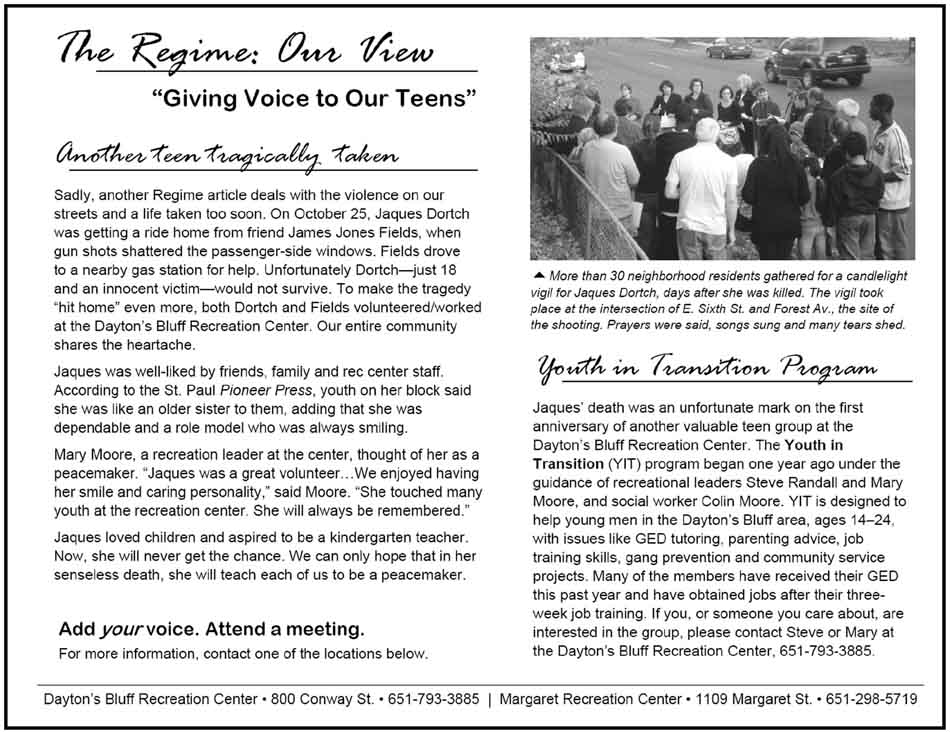 |
|
|
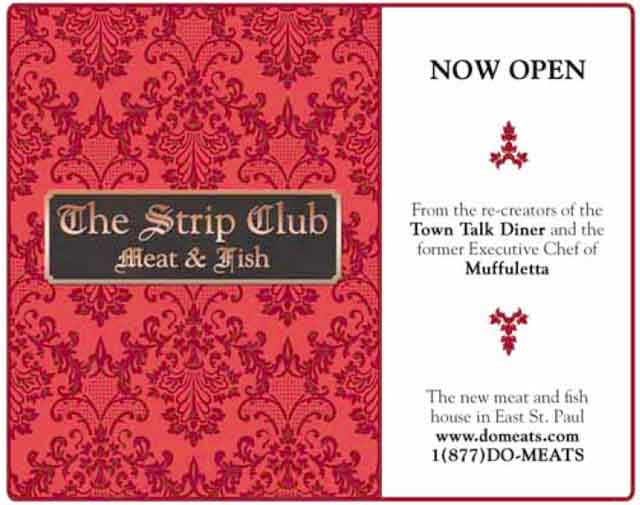 |
|
|
 |
|
|
 |
|
|
| Past issues of the Dayton's Bluff District Forum |
